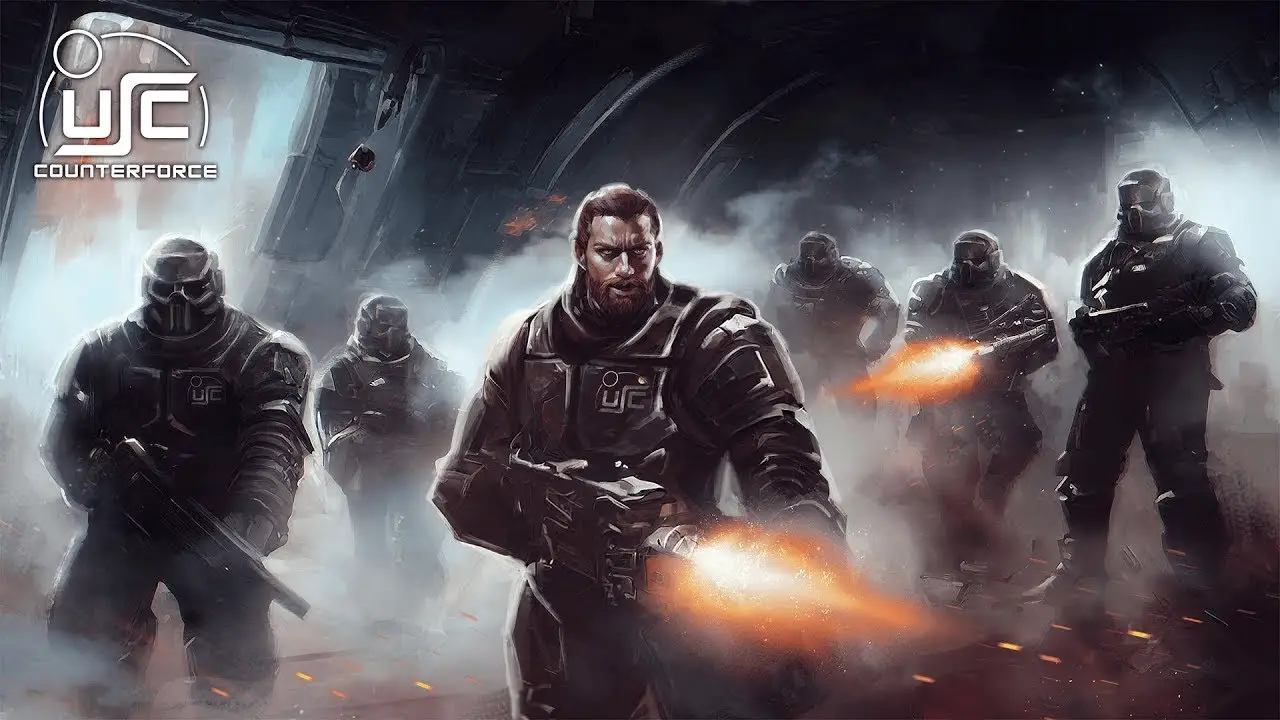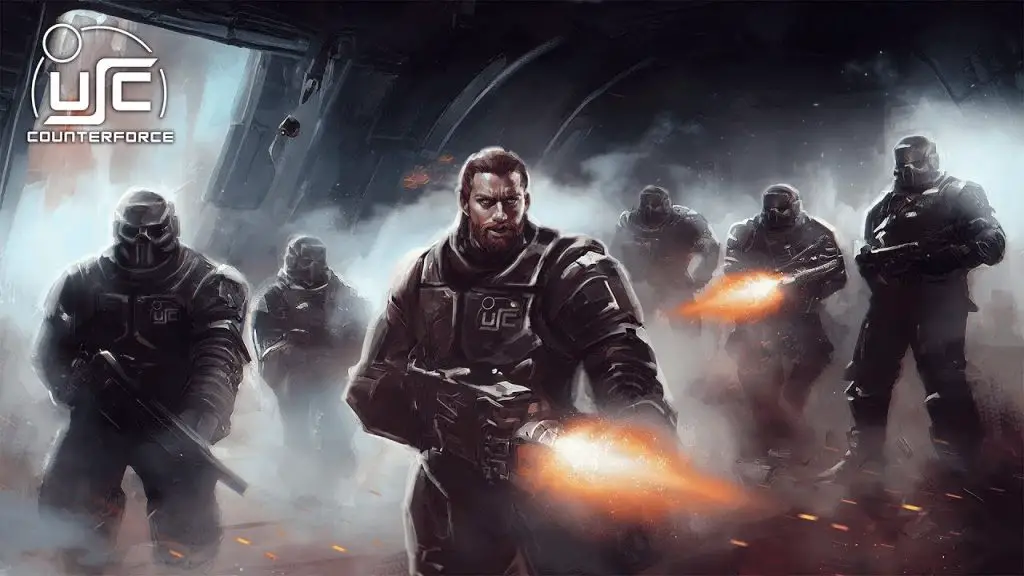
Finally, it has arrived! USC Counterforce reaches its ‘final frontier’ with the release of a new campaign mode, the largest component of this military-themed, squad-geared strategy game. Set in space with a focus on turn-based tactical combat, the campaign takes existing modes (missions, operations, defend the base) and combines them with a strategic layer that involves factions, planetary mining and economic management. Together these elements are infused with a corporate led story that demands repulsing an alien horde hell-bent on overrunning the player’s bases and their efforts towards victory.
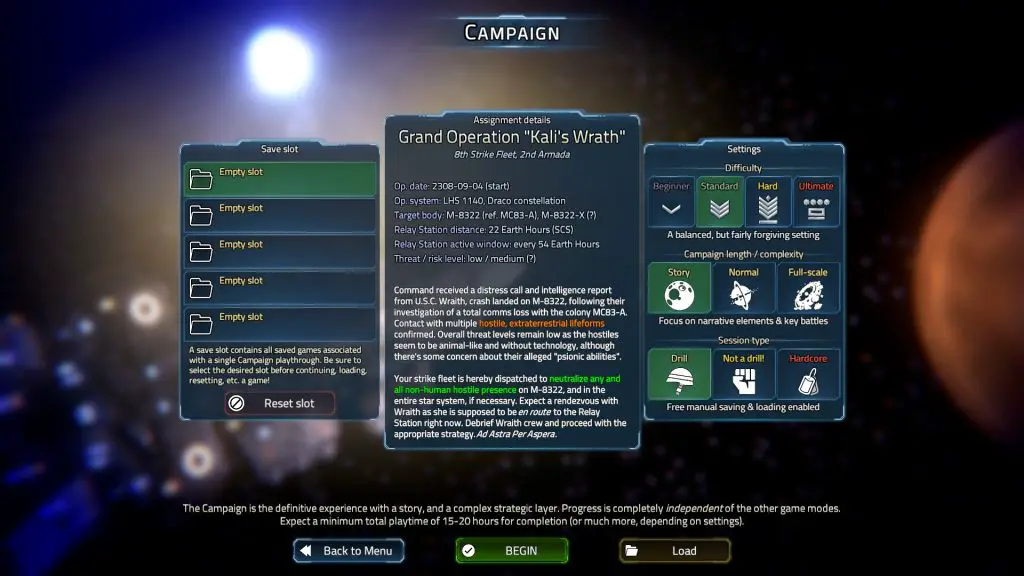
BACKGROUND
► This review was originally written while playing the Campaign BETA v0.90.3a at Standard Difficulty. This version was not feature complete, nor fully polished and was missing some QoL. It has been updated after playing some of the full v1.0 release.
► GAME SETUP is limited providing only a little variation for player’s to choose their preferred experience. These options are restricted to difficulty, mode length and saving limitations. The PLANETARY MAP is procedurally created with a fixed size of thirty-five hexes. Larger or smaller planet sizes cannot be created. Nor can elements such as terrain type, weather, nests, Deothonit deposits and other points of interest be set manually. Horde strength or, the number and frequency of nests seem be defined by difficulty.
► The STORY is basic, a corporation led dance of justification for missions and other activities on the planet. It serves its purpose but lacks the cinematic substance of a bonafide RPG or adventure game. Without it the campaign would essentially be a never ending sequence of combat missions broken up by elements of base-building, and faction, reputation and economy management.
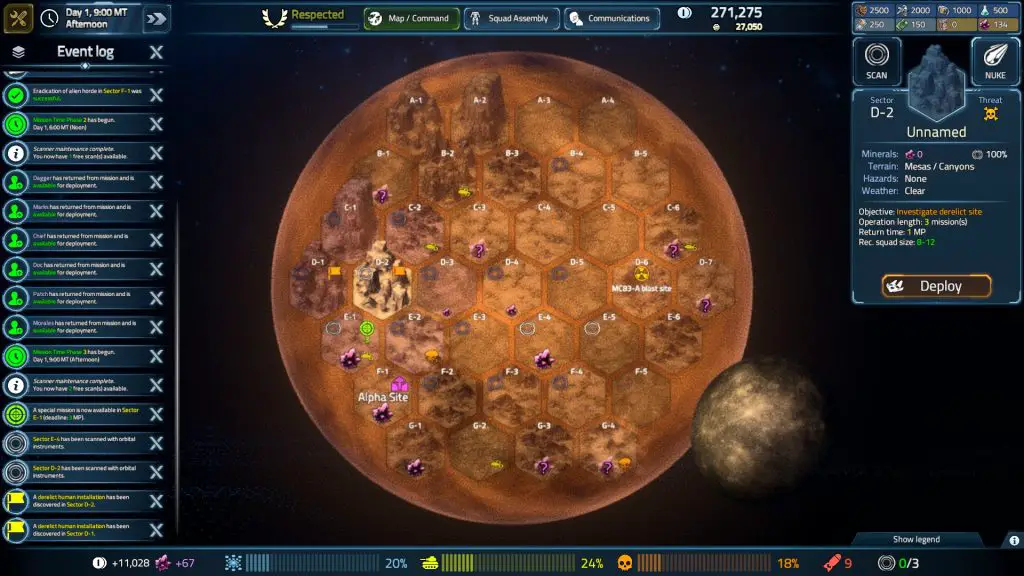
STRATEGY
► The game needs more STRATEGIC ASSETS (or options) to affect specific hexes as there are only a limited number in the form of tactical nukes and orbital scans. These are finite actions that can be performed on a per turn basis. The former provides some respite from the wave of incessant horde missions the player will have to undertake during the course of a campaign. The latter allows for intel gathering across multiple hexes upon use.
► Communicating and interacting with CORPORATE FACTIONS is limited to story interactions and requesting technology. Relations with each one must be kept high in order to retain a whole range of select services that include: access to exclusive equipment, blueprints for advanced prototypes, additional strategic assets or the ability to convert materials and resources. This feature could be expanded to provide ‘choice’ personnel to replace fallen or heavily wounded soldiers. Otherwise they will have to make do with ‘raw recruits.’
► RENOWN is a reputational gauge that rises or lowers depending on the player’s performance in the field. When low there is a chance that squad mates will become unreceptive to commands and even the possibility of mutiny in the ranks. Completing operations increases renown (reputation) ensuring soldiers remain loyal and opens up access to corporate inventory and tech. Seeming a little lite in terms of impact, perhaps it too could be a factor in the availability of elite level replacements and/or for quicker access to inventory and advanced tech.
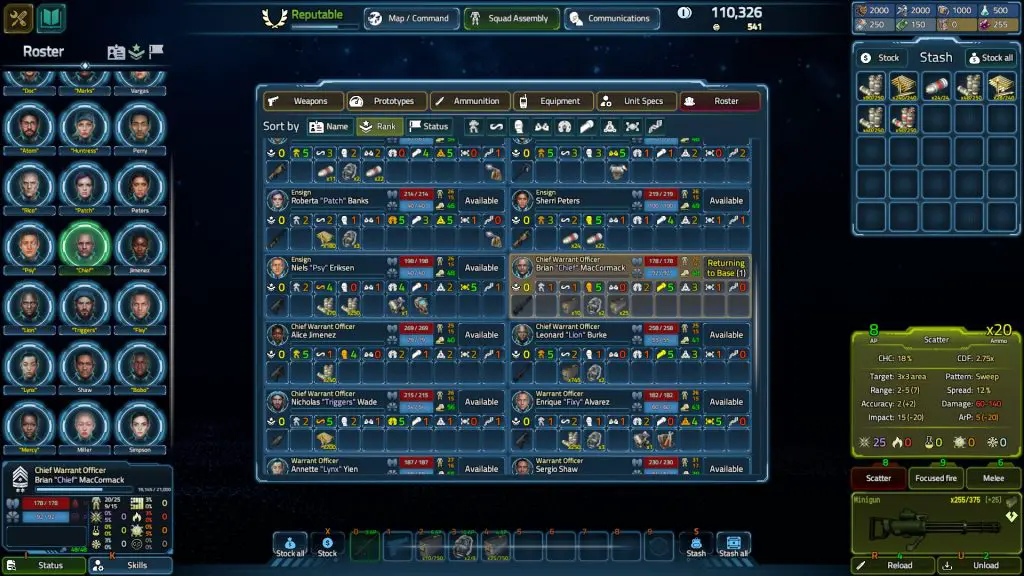
MANAGEMENT
► The only true CHARACTER CREATION is for the player’s main character, which is disappointing if like me you enjoy taking the time to min/max your entire squad. Instead the player receives over twenty PRE-ASSEMBLED soldiers. Each is given only a few spare points to assign to skills. Likely a decision to give soldiers their own personality and skill sets used to determine their role in combat. At least the freedom to assign additional skill points earned during the campaign remains.
► BASE-BUILDING is forced upon players. Thus even if like me you just want to focus on strategic management and/or tactical combat, you cannot. Being familiar with the process isn’t enough to adequately use the limited resources available and efficiently construct bases to maximise revenue. I found it laborious especially given the lack of alerts when veins of Deothonit run out. Something that would require the shutdown, expansion or relocation of those facilities to untouched deposits.
► Given the setting it’s a pity that LOGISTICS do not play a stronger role. Requisition of inventory, replacements and even interstellar communication occurs to quickly. The former seemingly having no manufacturing limits and being ‘infinite’ in number. An abstracted storage area on spaceships could have formed a repository of immediately available inventory, which could have been repopulated periodically with incoming shipments. This restriction would have caused an additional impact on the strategic layer if say those shipments were running late or arrived with incomplete manifests.
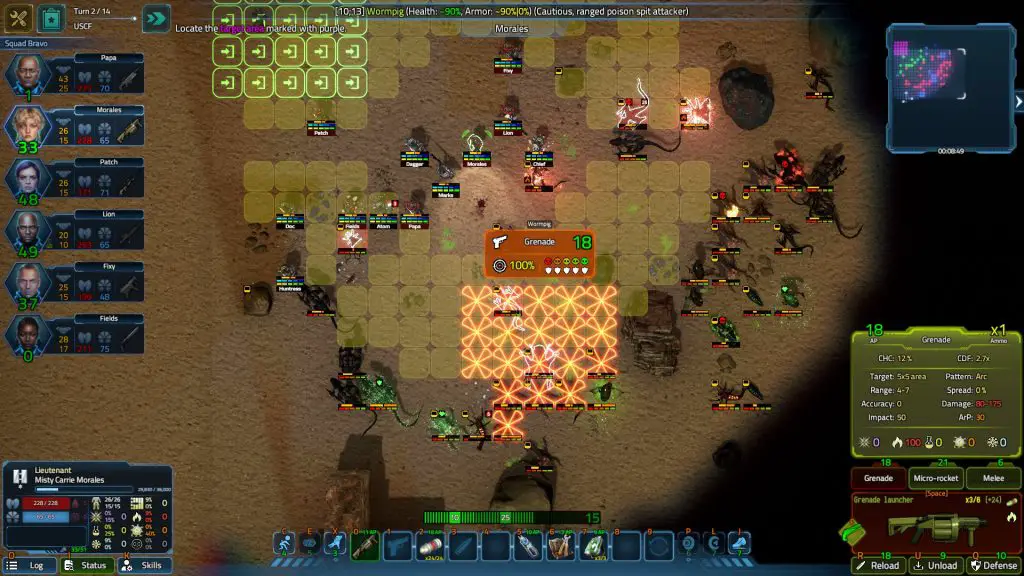
GAMEPLAY
► TBT COMBAT excels since it has the maturity of previously developed modes. Combatants have a wonderful plethora of options at their disposal. Overwatch standouts out as the premier reserve of the tactician. Though an option to bypass ill-equipped soldiers for teammates with a better choice of weapon down the line is not there. Weapons are detailed enough to have several attack modes and friendly fire overrides. Perhaps the most popular sought-after feature would be to have a few weapons with dual attack modes or the choice of modifications instead of firing patterns.
► While combat is enjoyable eventually MISSION REPETITION can become a jarring experience because of the high frequency of horde encounters. Here the game could benefit with some automation by abstracting encounters and showing a progress report on how encounters are going. This strategic overview would indicate to the player information such as kills, ammo reserves, soldier injuries and progress to objectives. At a point any squads were getting into trouble, the player could interrupt the process and jump into combat or choose retreat, or auto-resolve if the mission were going to plan. Factors leading to success could include soldier experience, ammo levels or having the equipment needed.
► The sheer volume of items available as INVENTORY is truly majestic. A TBT fan’s dream! Different weapons, ammo types, medical equipment, engineering tools and armour have their own tactical use, depending on the character, mission or situation. While the acquisition of experimental items ensures that access to these items remains strategically relevant to the end game.
► A real BUGBEAR and another potential candidate for automation is the need to constantly re-arm and re-equip the same squad of soldiers with the same items and ammo for their next mission. While involving at first, performing this repeatedly for a twenty+ soldiers for dozens of missions becomes tiresome if nothing needs changing. This sort of micromanagement should be avoided by at least providing the option to auto-replenish ammo or any equipment used per each soldier, or to provide a single button to reequip the entire squad.
► ENEMIES already come in a great range of types that hold a diverse set of abilities. Enough to present a solid range of tactical problems for players to plan for and overcome. The AI on the xenomorph level works well to swamp the player. Sometimes cover is used to good effect. Though a good portion of its success is fuelled by the player’s own mistakes.
ENDGAME
► VICTORY CONDITIONS for this mode are not defined in concrete terms. Instead three strategic gauges encourage the player to use the actions and assets under their control and raise these to a sufficient level to trigger victory. The first – Intel, requires constant scanning of the planet to ensure ‘the big picture’ is maintained as much as possible. Control requires the elimination of xenomorph nests and hordes. Threat level indicates the amount of xenomorph hordes and nests currently in play. Something that needs to be kept under control.
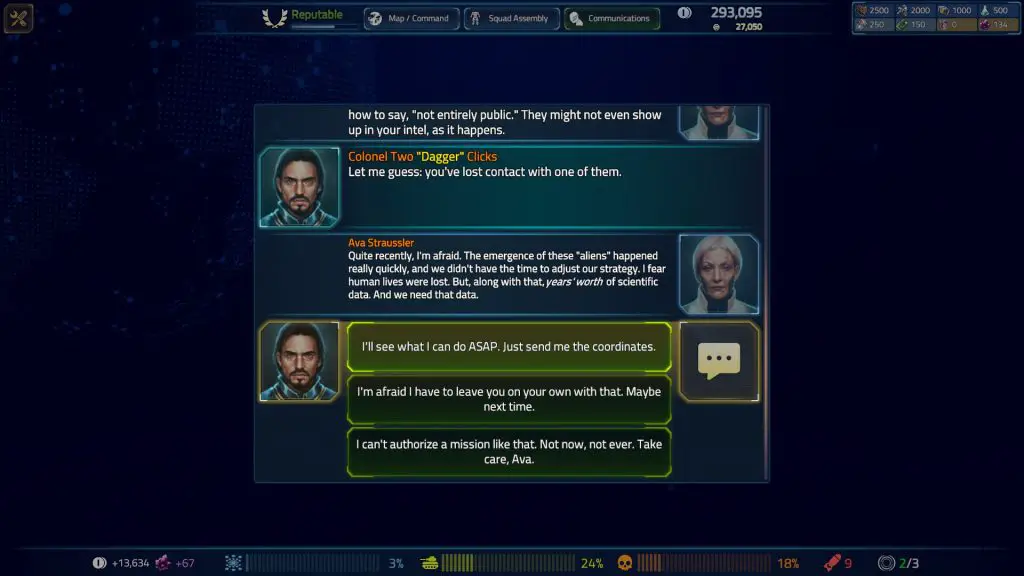
COMPLEXITY
🔶 ACCESSIBILITY – Info screens for tutorials were added in the full release. Without playing the previous mode as standalones, getting started and understanding how combat works will take some time to achieve.
🔶 DIFFICULTY – On standard difficulty the challenge is manageable, especially in terms of combat. However, the rate of credit and resource accumulation is quite tight and expenditure must be watched while the number of mining bases is grown at fast enough to ensure a surplus of credits is ready to fund any expansion or, to rearm and reequip squads for their next mission.
🔶 BALANCE – The player starts off with plenty of assets, but basic inventory. Credits are enough to commence operations, but allow little wiggle room for mistakes or the trying out of new strategies. As a result the economy system in this new mode needs some tweaking to allow players to generate wealth a little faster or alternatively reduce the rate of hordes attacking initially. Again dependent of difficulty.
🔶 PACE – The only real parameters that drive the tempo of the game is the story and the rate at which hordes manifest, which are generated by nests. This is a little too fast on story difficulty. Otherwise the player can choose when to take on available missions before them.
STAYING POWER
🟨 REPLAY VALUE – This mode is designed to be replayed over and over, but more dynamic factors would make it a lot more worthwhile given the repetitive nature of combat. Specifically horde missions. The story seems fairly scripted, though specific mission parameters will change from session to session.
🟨 LONGEVITY – The various setup options for this mode, including difficulty and campaign type provide a fair amount. Customisation of planet size and make-up would increase this even more. Achievements will be a tough slog for casual players.
PRODUCTION
🟣 QUALITY – Given that the quality of existing game modes were already quite mature, the only lacking aspects are QoL and polish. Some bugs have been reported, but either uptake on the beta was low or there just aren’t (m)any game breaking issues. Support will be ongoing, but the game has already been supplied with a few minor hotfixes.
🟣 STABILITY – The very few crashes experienced were due to my borderline minimum specs.
🟣 STEAM – An assortment of challenging achievements aimed at completing modes across difficulties. Cloud saving. Overlay screenshot capture. Remote play possible for coop, but only the host progresses in campaign mode.
🟣 OPTIMISATION – While able to play the previous modes without a problem, this new version of the mode suffers from crippling load times despite having an SSD. During the campaign beta the game would run at around 50-60 fps with some noticeable micro-freezes. Make sure that the PC especially the processor is better than the current posted minimum specs.

VERDICT
This new campaign mode already has a solid range of enticing features that deliver an enjoyable and cohesive experience by bringing all it’s existing components together. What there currently is provides a great platform that could become even better to play if a few more elements are intelligently added into the mix.
A few more dynamic factors and strategic elements to increase variety in gameplay would be most welcome. Factions need to be expanded upon to make them more relevant. While the largest hurdle to overcome is centred on QoL to automate certain mundane features. Overall the campaign mode for USC: Counterforce is already a very playable and satisfying addition, ready for any final touches the developers may decide to incorporate from the game’s passionate community.

